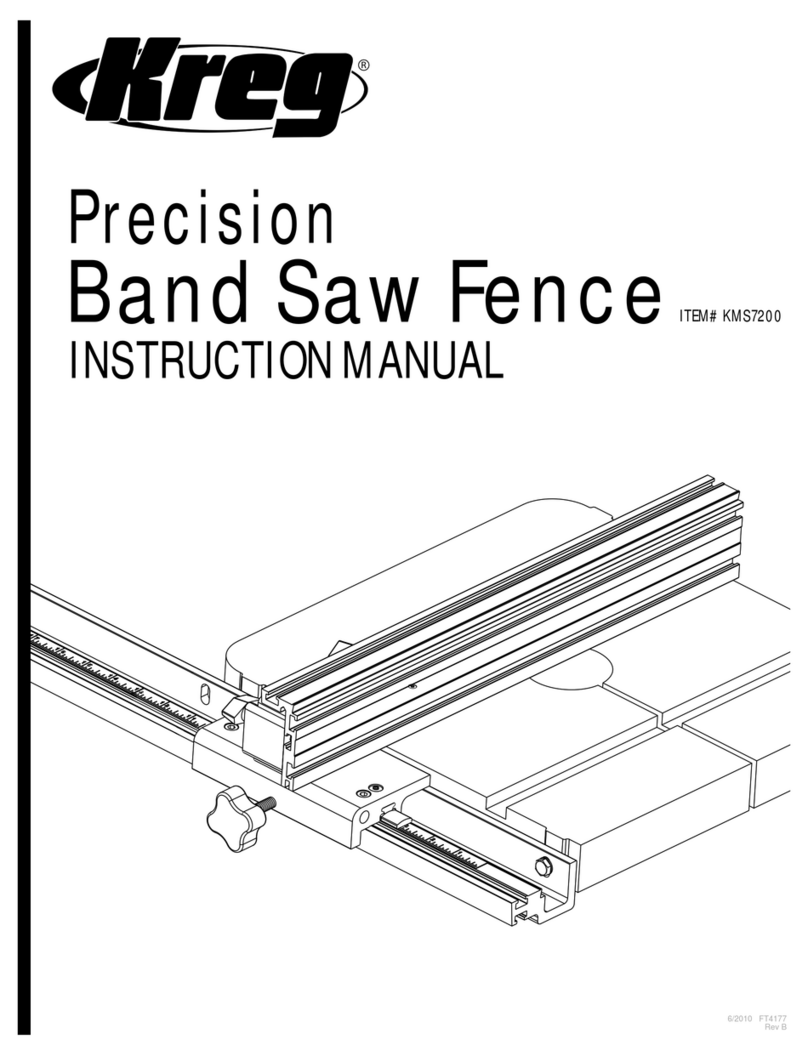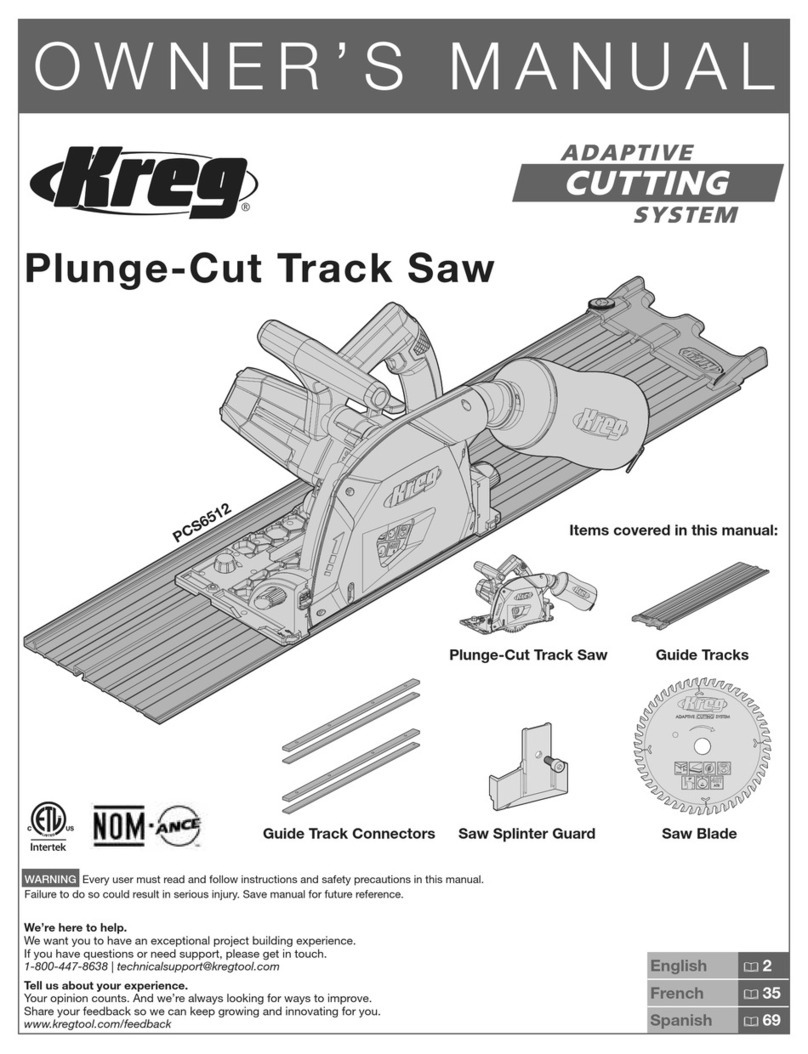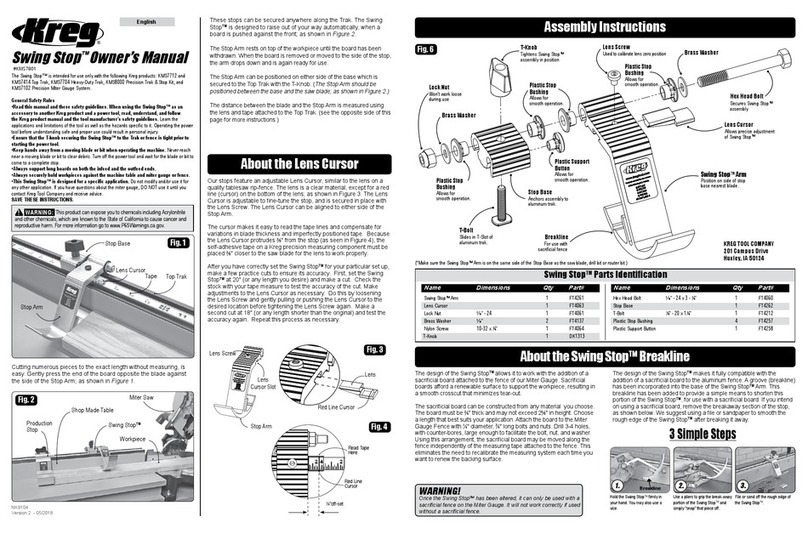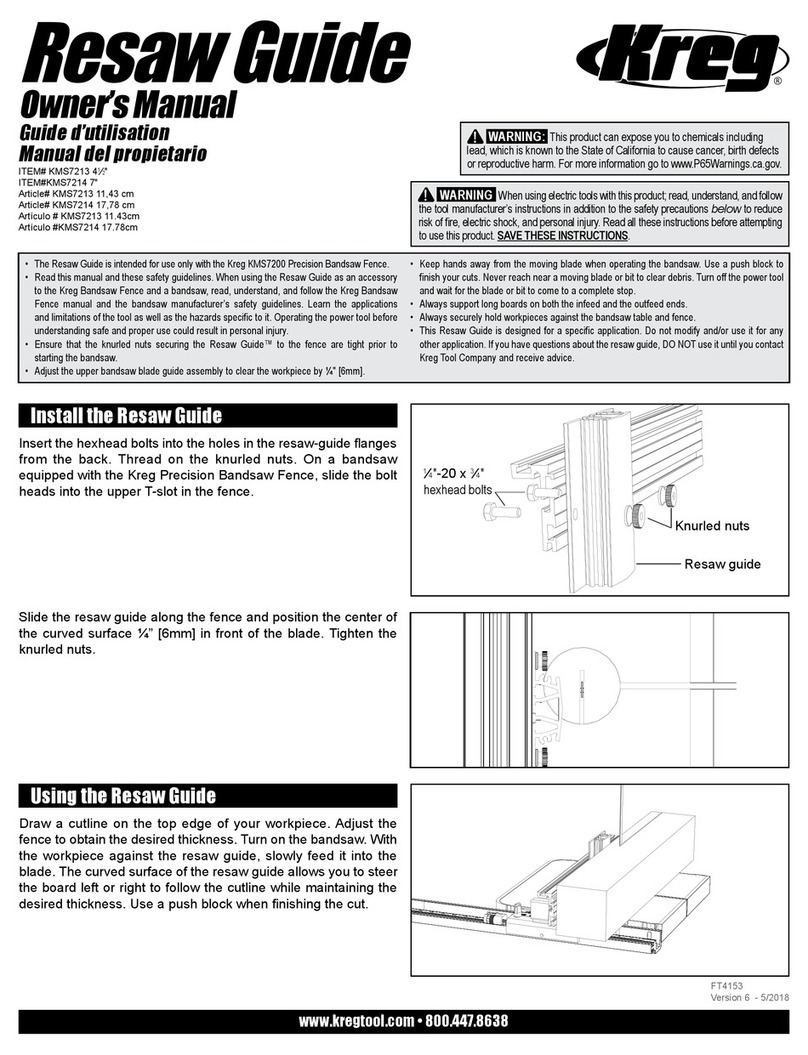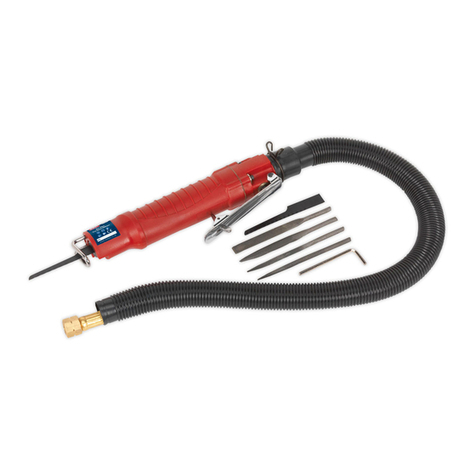Kreg KMS7200 User manual

Band Saw Fence
Precision
OWNER’S MANUAL
Item# KMS7200
Tools Required:
• 7⁄16" or 10mm wrench
• Electric drill, 11⁄32" drill bit, le (if necessary)
• Combination square (optional)
• 1⁄2" wrench
• Phillips screwdriver
• 5⁄32" and 3⁄16" hex wrenches
www.kregtool.com • 800.447.8638
FT4177
Version 4 - 01/2018

Table of Contents
1.
Read all instructions and safety warnings before using this tool.
SAFETY 2
PARTS DIAGRAM 3
CHECK THE RAIL SLOTS AND MOUNTING BOLTS 4
DRILL THE MOUNTING RAIL (When Necessary) 4
INSTALL THE MOUNTING RAIL 5
ASSEMBLE THE CLAMP BLOCK 6
ATTACH THE FENCE EXTRUSION 6
ADHERE THE MEASURING TAPE 7
PARALLEL ADJUSTMENT 7
BLADE DRIFT ADJUSTMENT 8
FEATURES 9
ACCESSORIES 10
WARRANTY 11

Safety Guidelines 2.
!
General Safety Rules
WARNING! To reduce the risk of injury, user must read the instruction manual.
WARNING! Read all instructions. Failure to follow all instructions listed below may result in electric shock, re and/or serious injury. The term
“power tool” in all of the warnings listed below refers to your mains-operated (corded) power tool or battery-operated (cordless) power tool.
SAVE THESE INSTRUCTIONS
1) Work area safety
a) Keep work area clean and well lit. Cluttered or dark areas invite accidents.
b) Do not operate power tools in explosive atmospheres, such as in the presence of ammable liquids, gases or dust. Power tools create sparks which may ignite the dust or fumes.
c) Keep children and bystanders away while operating a power tool. Distractions can cause you to lose control.
2) Electrical safety
a) Power tool plugs must match the outlet. Never modify the plug in any way. Do not use any adapter plugs with earthed (grounded) power tools. Unmodied plugs and matching outlets
will reduce risk of electric shock.
b) Avoid body contact with earthed or grounded surfaces such as pipes, radiators, ranges and refrigerators. There is an increased risk of electric shock if your body is earthed or grounded.
c) Do not expose power tools to rain or wet conditions. Water entering a power tool will increase the risk of electric shock.
d) Do not abuse the cord. Never use the cord for carrying, pulling or unplugging the power tool. Keep cord away from heat, oil, sharp edges or moving parts. Damaged or
entangled cords increase the risk of electric shock.
e) When operating a power tool outdoors, use an extension cord suitable for outdoor use. Use of a cord suitable for outdoor use reduces the risk of electric shock.
3) Personal safety
a) Stay alert, watch what you are doing and use common sense when operating a power tool. Do not use a power tool while you are tired or under the inuence of drugs, alcohol or medication.
A moment of inattention while operating power tools may result in serious personal injury.
b) Do not allow familiarity gained from frequent use of a tool to replace safe work practices. A moment of carelessness is sufcient to cause severe injury.
c) Use safety equipment. Always wear eye protection. Safety equipment such as dust mask, non-skid safety shoes, hard hat, or hearing protection used for appropriate conditions
will reduce personal injuries.
d) Avoid accidental starting. Ensure the switch is in the off-position before plugging in. Carrying power tools with your nger on the switch or plugging in power tools that have the
switch on invites accidents.
e) Remove any adjusting key or wrench before turning the power tool on. A wrench or a key left attached to a rotating part of the power tool may result in personal injury.
f) Do not overreach. Keep proper footing and balance at all times. This enables better control of the power tool in unexpected situations.
g) Dress properly. Do not wear loose clothing or jewelry. Keep your hair, clothing and gloves away from moving parts. Loose clothes, jewelry or long hair can be caught in moving parts.
h) If devices are provided for the connection of dust extraction and collection facilities, ensure these are connected and properly used. Use of these devices can reduce
dust-related hazards.
4) Power tool use and care
a) Do not force the power tool. Use the correct power tool for your application. The correct power tool will do the job better and safer at the rate for which it was designed.
b) Do not use the power tool if the switch does not turn it on and off. Any power tool that cannot be controlled with the switch is dangerous and must be repaired.
c) Disconnect the plug from the power source and/or the battery pack from the power tool before making any adjustments, changing accessories, or storing power tools.
Such preventive safety measures reduce the risk of starting the power tool accidentally.
d) Store idle power tools out of the reach of children and do not allow persons unfamiliar with the power tool or these instructions to operate the power tool. Power tools are
dangerous in the hands of untrained users.
e) Maintain power tools. Check for misalignment or binding of moving parts, breakage of parts and any other condition that may affect power tool operation. If damaged,
have the power tool repaired before use. Many accidents are caused by poorly maintained power tools.
f) Keep all guards and safety devices in place, properly adjusted, and in good working order.
g) Keep cutting tools sharp and clean. Properly maintained cutting tools with sharp cutting edges are less likely to bind and are easier to control.
h) Use the power tool, accessories, bits, and blades in accordance with these instructions and in the manner intended for the particular type of power tool, taking into account the
working conditions and the work to be performed. Use of the power tool for operations different from those intended could result in a hazardous situation.
i) Never stand on the tool. Serious injury could occur if the tool tips or if cutting edges are accidentally contacted.
j) Never leave a running tool unattended. Turn off the power and do not leave the tool until moving parts come to a complete stop.
5) Service
a) Have your power tool serviced by a qualied repair person using only identical replacement parts. This will ensure that the safety of the power tool is maintained.
6) Additional Safety Rules for the Precision Band Saw Fence
a) Read this manual and these safety guidelines. Follow the saw manufacturer’s safety guidelines. Learn the applications and limitations of the tool as well as the hazards
specic to it. Operating the tool before understanding safe and proper use could result in personal injury.
b) Ensure that the lock knob is tight and the fence extrusion T-knobs are secure prior to starting the band saw.
c) Keep hands away from the moving blade when operating the machine. Never reach behind the moving blade to clear debris.
d) Always support long boards on both the infeed and the outfeed end of the blade.
e) Always securely hold workpieces against the table and fence.
f) This fence system is designed for a specic application. Do not modify and/or use it for any other application. If you have questions about the band saw fence,
DO NOT use it until you contact Kreg Tool Company and receive advice.
!
WARNING:
!
This product can expose you to chemicals including
Acrylonitrile and other chemicals, which are known to the State of California
to cause cancer and reproductive harm. For more information go to
www.P65Warnings.ca.gov.
WARNING:
!
Drilling, sawing, sanding or machining wood products can
expose you to wood dust, a substance known to the State of California to cause
cancer. Avoid inhaling wood dust or use a dust mask or other safeguards for
personal protection. For more information go to www.P65Warnings.ca.gov/wood.

Assembly
3.
DK1313 2 T-knobs
DK1504 4 1⁄4" brass washers
FT4025 2 1⁄4"-20 x 3⁄4" nylon socket head screws
FT4047 1 Right-to-left reading self-adhesive tape
FT4063 1 Lens cursor
FT4064 1 #10-32 x 1⁄4" nylon screw
FT4136 1 Fence extrusion
FT4137 2 5⁄16" brass washers
FT4138 2 1⁄4"-20 x 21⁄2" hex head bolts
FT4140 2 #10-32 x 3⁄8" nylon set screws
FT4159 1 Mounting rail
FT4143 1 Clamp block
FT4144 1 Fence bracket
FT4185 2 1⁄4"-28 x 11⁄4" hex head bolts (Delta)
FT4146 2 M6-1 x 30mm hex head bolts
(Jet, Craftsman, Ridgid, and other imports)
FT4175 2 5⁄16" x 3⁄4" hex head bolts
FT4176 1 Lock knob
Part Number Quantity Description
DK1313
FT4047
FT4063
FT4136
FT4176
FT4159
FT4143
FT4144
FT4064
DK1504
FT4137
FT4138
FT4175
FT4025
FT4185 (Delta)
FT4146 (Jet, Craftsman, Ridgid, Import)
FT4140
DK1504
Band Saw Fence
Parts Diagram

Assembly 4.
For band saws with a left-hand table hole that does not align with
a left-hand slot in the mounting rail, mark the left-hand table hole
centerline on the saw table with a pencil. Mount the rail by inserting a
mounting bolt through the right-hand rail slot and threading it into the
right-hand saw-table hole. Snug, but do not tighten the bolt. Mark the
left-hand slot centerline on the rail.
Remove the mounting rail from the saw table and transfer the
centerline onto the back of the mounting rail. Mark hole centers on the
rail with a center punch. Drill overlapping 11⁄32" holes and use a le to
nish forming the slot.
The positions of the slots in the mounting rail match the threaded holes in
the front edge of the tables of most band saws. The drawing shows slot
locations that match several popular brands. Other manufacturers use the
same locations. For brands not shown, align the right-hand mounting-rail
slot with the right-hand saw-table hole to see which left-hand rail slot aligns
with the left-hand table hole. If a left-hand slot does not align with the table
hole, see the section, Drill the Mounting Rail.
Two sets of mounting bolts are included with the Precision Band Saw
Fence: 1⁄4"-28 x 11⁄4" hex head bolts for some Delta saws and M6-1 x 30mm
hex head bolts for Jet, Craftsman, Ridgid, and others. You’ll need a 7/16"
wrench for the 1⁄4"-28 bolts and a 10mm wrench for the M6-1 bolts. Test-t
the bolts in the saw-table holes to determine which ones to use.
Tip
The threaded mounting holes in your band saw table may contain debris
that make it difcult to drive the mounting bolts. To clear the debris,
thread-in and back-out the bolts several times, clearing loosened debris
with compressed air or a shop vacuum. If the bolts do not thread fully, you
may need to clean the threads with a tap. Consult your band-saw owner’s
manual or contact the saw manufacturer for the correct thread size.
Hold the left-hand end of the mounting rail in position
and transfer the saw-table hole centerline onto the rail.
Check the Rail Slots and Mounting Bolts
Drill the Mounting Rail (when necessary)
Disconnect the band saw from the power supply when installing the Precision Band Saw Fence.
Jet, Ridgid
Delta
Craftsman
top edge of mounting rail
remove area with le
11/32” hole
5/8" 1/8"

Assembly
5.
Slip a washer over one mounting bolt, insert the bolt through the right-
hand rail slot, and thread it into the right-hand saw-table hole. Snug, but
do not tighten the bolt. Slip a washer over the other bolt. Holding the rail
in position, insert the bolt into the appropriate rail slot and thread it into
the saw-table hole. Snug the bolt. Align the rail parallel to top surface of
the saw table and with the top edge of the rail 1⁄16" below the bottom of
the miter-gauge slot. Tighten the bolts.
Tip
Set the blade of your combination square to the miter gauge slot depth
plus 1⁄16". Then use the square to position the top edge of the mounting
rail at each mounting bolt.
Loosely fasten the rail at the right-hand end, then rotate
the rail into position and secure the left-hand end.
Install the Mounting Rail
1⁄16"

Assembly 6.
Insert the T-shaped stem of the lens cursor into the clamp block, letting
the entire lens body protrude beyond the edge of the clamp block.
Secure the lens cursor with the #10-32 x 1⁄4" nylon screw.
Thread two #10-32 x 3⁄8" nylon set screws into the the rear corner
holes in the clamp block. Adjust the set screws to protrude 1⁄16" below
the bottom surface of the block. These screws act as glides to provide
smooth fence movement.
Thread two 1⁄4"-20 x 3⁄4" nylon socket head screws into the front corner
holes in the clamp block until the ends of the screws are ush with the
bottom surface of the block.
Slip a 5⁄16" brass washer on each of the 5⁄16" x 3⁄4" hex head bolts, insert
them through the fence bracket, and thread them into the clamp block.
Make sure the large hole in the fence bracket aligns with the rear hole
in the clamp block. Align the fence bracket square with the clamp block
and tighten both bolts.
Thread the lock knob into the front face of the clamp block until the
swivel pad protrudes 1⁄16" beyond the inside surface. Position the clamp
block assembly on the mounting rail and lightly tighten the lock knob to
hold the assembly in place.
Assemble the Clamp Block
Insert the head of each 1⁄4"-20 x 21⁄2" hex head bolt into the T-slot in
the back of the fence extrusion. With one bolt in each U-shaped fence
bracket upright, position the fence extrusion against the bracket with
the bottom edge resting on the saw table. Slip a 1⁄4" brass washer onto
each bolt and thread on a T-knob.
Test the operation of the Precision Band Saw Fence by sliding it from
side to side along the mounting rail.
Tip
To obtain smooth right-to-left fence movement, tighten the lock knob to
square the clamp block with the mounting rail. Then loosen the knob
just enough to allow the fence to slide.
Attach the Fence Extrusion
Lens cursor
Fence bracket
#10-32 x 1/4"
Nylon screw
#10-32 x 3/8"
Nylon set screw
Lock knob
1/4"-20 x 3/4"
Nylon socket
head screw
5/16" Brass washer
5/16 x 3/4" Hex head bolt
Clamp block
T-knob
Fence extrusion
Fence bracket
Lock knob
1/4" Brass washer
1/4" - 20 x 2-1/4"
Hex head bolt

Assembly
7.
Position the fence extrusion against, but not deecting, the blade and
tighten the lock knob. With a pencil, mark a line on the mounting rail in
front of and behind the red line on the lens cursor. Loosen the lock knob
and remove the fence from the mounting rail.
Peel the backing from the zero end of the self-adhesive measuring
tape, exposing about one inch of the adhesive. Align the tape zero mark
with the pencil lines on the mounting rail and press the tape into the
shallow groove in the rail. With the rst inch of tape adhered, pull the
remaining backing from under the tape, rmly pressing the tape into the
groove as you proceed.
Reinstall the fence assembly on the mounting rail and check the
position of the red cursor line against the zero mark on the measuring
tape. Re-zero the red line as necessary by loosening the screw that
holds the lens cursor in place, readjusting the cursor position, and
retightening the screw.
Tip
To make the measuring-tape backing easy to remove, fold the rst inch
of backing so it protrudes from the tape at an angle. With the rst inch
of tape adhered, pull the backing from under the tape, pressing the tape
into the mounting rail groove as you continue to remove the backing.
Adhere the Measuring Tape
Mark the position of the red cursor line on the mounting rail.
Align the measuring tape zero mark with the pencil
marks, peel away the backing, and adhere the tape.
To ensure that the face of the fence extrusion is parallel to the blade, rst
make sure your band saw table is perpendicular to the blade. See your
band saw owner’s manual for instructions on making this adjustment.
With the band saw table properly adjusted, position the fence assembly on
the mounting rail and lightly tighten the lock knob to hold the assembly in
place. Thread in the nylon screws at the front corners of the clamp block
until the tips contact the surface of the mounting rail. Check the alignment
of the face of the fence extrusion and the saw table with a square. To
adjust the alignment, loosen the lock knob and turn the right hand or left
hand screw to tilt the fence as needed. With the fence square to the saw
table, tighten the lock knob and adjust the nylon set screws at the back
corners of the clamp block so the tips contact the mounting rail.
Tip
Parallel adjustment is particularly important for cuts in which even a
small difference between the top and bottom of the cut will give poor
results, such as when cutting tenons, dovetails, and thin veneers.
Adjust either the left or right screw to align the face of
the fence extrusion perpendicular to the saw table.
Parallel Adjustment
Pencil marks

Assembly 8.
Sometimes when using the fence, a band saw will make a cut that does
not track parallel to the fence, either wedging the workpiece between
the fence and the blade or pulling the workpiece away from the fence.
This “drift angle” often is caused by a blade with teeth that are not set
evenly or that have become dull on one side.
To adjust your fence to compensate for the drift angle, remove the
fence assembly from your band saw and set it aside. Mark a line down
the center of a scrap board about 2" wide and 30" long. Cut on the line
to the middle of the scrap board. Hold the board rmly in place, shut off
the band saw and wait for the blade to come to a complete stop. The
angle at which you fed the board in order to keep the blade cutting on
the line is the drift angle. Use a pencil to trace a line onto the band saw
table along one edge of the board. Remove the board.
Remount the fence assembly on your band saw and loosen the bolts
that attach the fence bracket to the clamp block.
Align the fence with the pencil line on the table surface. Tighten the
lock knob, recheck the fence alignment, and tighten the fence bracket
bolts. Make a test cut to ensure that the workpiece tracks parallel to the
fence.
Tip
If you are not able to adjust the fence to the angle necessary to
compensate for blade drift, either your saw geometry is out of
adjustment or it is time to replace the blade. You can minimize the
amount of blade drift by adjusting the tracking and the tension on the
band saw. Refer to your band saw manufacturer’s instructions.
Blade Drift Adjustment
Loosen the fence bracket bolts to allow the fence
extrusion to pivot.
With the blade stopped, trace a line along the edge
of the board onto the saw table
The fence extrusion/fence bracket assembly pivots
for alignment with the blade drift angle.
Pencil line

Features
9.
• The fence can be used on either side of the blade simply by switching
the fence extrusion from one side of the fence bracket to the other.
• Position the fence extrusion anywhere along the fence bracket by
loosening the T-knobs and sliding the extrusion along the face of the
bracket. For example, to use the fence as a cutoff guide, position
the end of the extrusion slightly in front of the blade and feed the
workpiece with a miter gauge. The piece will be clear of the blade
when cut free and will not be caught between the blade and fence.
• Switch the fence extrusion orientation from vertical to horizontal for
optimum upper blade guide support. Simply loosen the T-knobs, slide
the fence extrusion off the bolts, ip it over and slide the bolt heads
into the T-slot on the top of the extrusion.
With the blade close to the fence, the vertical orientation allows
lowering the upper blade guide only to the top of the fence extrusion.
The horizontal fence position allows the blade guard to be lowered
to within 1⁄2” of the saw table.
• The clamp block features a threaded insert that accepts the optional
Micro-Adjuster accessory.

Optional Accessories for your Precision Band Saw Fence 10.
Precision Micro-Adjuster , KMS7215
Dial-in precise adjustments to your Precision Band
Saw Fence. This accessory installs without tools or
modications.
Re-Saw Guide , 4 ½" - KMS7213, 7" - KMS7214
Increase vertical support and compensate for blade drift
or stock irregularities on the y when resawing. Available
in 41⁄2"-tall and 7"-tall sizes.

WARRANTY
11.
WARRANTY
KREG PRECISION BAND SAW FENCE
Kreg Tool Company products are warranted
to be free of defects in materials and
workmanship for a period of one (1) year
from the date of delivery to the original
purchaser. This warranty is extended only to
the original purchaser and covers only Kreg
products purchased directly from Kreg Tool
Company and its authorized distributors.
During the warranty period, Kreg Tool
Company, at its option, will repair or replace
any product or component part thereof
proving defective. This warranty applies
only to products used in accordance with
proper operation, maintenance and safety
procedures set forth in catalogs, manuals,
and other instructional materials furnished by
Kreg Tool Company.
This warranty is in effect only if the warranty
registration card included with the product is
fully and properly completed and returned to
Kreg Tool Company within ten (10) days from
the date of delivery to the original purchaser.
This warranty is null and void if the product
has been subjected to (1) neglect, improper
service, or improper storage; (2) misuse,
abuse, accident, or other circumstances
beyond Kreg Tool Company control; and
(3) modication, alteration, tampering,
disassembly, or repairs executed outside
of the Kreg Tool Company factory or not
authorized by Kreg Tool Company. This
warranty does not cover normal wear and
tear, corrosion, abrasion, or damage due to
natural causes or acts of God.
To obtain warranty service, contact the
distributor from whom you purchased your
Kreg product or contact Kreg Tool Company
directly. Proof of purchase is required to
secure remedy under the terms of this
warranty. Kreg Tool Company assumes no
responsibility for products returned without
prior authorization. Kreg Tool Company
obligations under this warranty shall be
exclusively limited to repairing or replacing
products determined to be defective upon
delivery to and inspection by Kreg Tool
Company. Under no circumstance shall
Kreg Tool Company be liable for incidental
or consequential damages resulting from
defective products, nor shall Kreg Tool
Company liability exceed the purchase price
of the product.
This constitutes Kreg Tool Company’s
sole warranty. Any and all other warranties
implied by law, including any warranties for
merchantability or tness for a particular
purpose, are hereby limited to the duration of
this warranty. Kreg Tool Company shall not
be liable for any loss, damage or expense
directly or indirectly related to the use of
Kreg products or from any other cause or for
consequential damages including without
limitation, loss of time, inconvenience, and
loss of production. The warranty contained
herein may not be modied and no other
warranty, expressed or implied, shall be
made by or on behalf of Kreg Tool Company.
The following information will be useful in the event warranty service is required.
Date of Purchase: ____/____/____
Purchased From: ____________________________________________
Kreg Tool Company 201 Campus Drive Huxley, IA 50124

du guide de scie à ruban
GUIDE D’UTILISATION
de précision
Item# KMS7200
Outils nécessaires :
• Clé de 7⁄16 po ou de 10 mm
• Perceuse électrique, foret de 11⁄32 po, lime (au besoin)
• Équerre combinée (facultative)
• Clé de 1⁄2 po
• Tournevis cruciforme
• Clés hexagonales de 5⁄32 po et de 3⁄16 po
www.kregtool.com • 800.447.8638
FT4177
Version 4 - 11/2017

Table des matières
1.
Avant d’utiliser cet outil, lisez toutes les instructions et tous les avertissements de sécurité.
SÉCURITÉ 2
SCHÉMA DES PIÈCES 3
VÉRIFICATION DES ORIFICES SUR LA TRAVERSE ET DES BOULONS DE MONTAGE 4
PERÇAGE DE LA TRAVERSE DE FIXATION (au besoin) 4
INSTALLATION DE LA TRAVERSE DE FIXATION 5
ASSEMBLAGE DU BLOC DE SERRAGE 6
FIXATION DU PROFILÉ DU GUIDE 6
AJOUT DU RUBAN À MESURER 7
RÉGLAGE DU PARALLÉLISME 7
RÉGLAGE DU MOUVEMENT DE LA LAME 8
CARACTÉRISTIQUES 9
ACCESSOIRES 10
GARANTIE 11

Consignes de sécurité 2.
!
Règles de sécurité générales
AVERTISSEMENT! An de réduire les risques de blessure, l’utilisateur doit lire le manuel d’instructions.
AVERTISSEMENT! Lisez toutes les instructions. Le non-respect des instructions présentées ci-dessous pourrait entraîner un choc électrique, un
incendie ou des blessures graves. Le terme « outil électrique » utilisé dans tous les avertissements qui gurent ci-dessous désigne les outils électriques
alimentés sur secteur (à l) ou alimentés par piles (sans l).
CONSERVEZ CES INSTRUCTIONS
1) Mesures de sécurité dans l’aire de travail
a) L’aire de travail doit être propre et bien éclairée. Une aire de travail encombrée ou peu éclairée augmente le risque d’accident.
b) N’utilisez pas d’outils électriques dans un milieu explosif, par exemple où il y a présence de liquides, de vapeurs ou de poussières inammables. Les outils électriques produisent
des étincelles susceptibles d’enammer ces poussières ou ces vapeurs.
c) Gardez les enfants et les autres personnes à l’écart lorsque vous utilisez un outil électrique. Une distraction peut vous faire perdre la maîtrise de l’outil.
2) Consignes de sécurité relatives à l’électricité
a) Les ches des outils électriques doivent correspondre à la prise. Ne modiez jamais la che de quelque façon que ce soit. N’utilisez pas d’adaptateur avec les outils électriques
mis à la terre. L’utilisation de ches non modiées dans les prises compatibles réduit les risques de choc électrique.
b) Évitez de toucher à des surfaces mises à la terre, par exemple un tuyau, un radiateur, une cuisinière ou un réfrigérateur. Le contact du corps avec une surface mise à la terre
augmente les risques de choc électrique.
c) N’exposez pas les outils électriques à la pluie ni à tout autre environnement humide. Les risques de choc électrique sont plus élevés si l’eau s’inltre dans un outil électrique.
d) N’utilisez pas le cordon d’alimentation de façon abusive. Ne transportez jamais un outil électrique en le tenant par son cordon, et ne tirez jamais sur le cordon pour le
débrancher. Tenez le cordon d’alimentation à distance des sources de chaleur, de l’huile, des objets coupants et des pièces mobiles. Les risques de choc électrique sont
plus élevés si le cordon d’alimentation est endommagé ou emmêlé.
e) Lorsque vous utilisez un outil électrique à l’extérieur, servez-vous d’une rallonge conçue pour être utilisée à l’extérieur. Ce type de rallonge réduit les risques de choc électrique.
3) Sécurité personnelle
a) Soyez vigilant, prêtez attention à ce que vous faites et usez de votre jugement lorsque vous utilisez un outil électrique. N’utilisez pas un outil électrique lorsque vous êtes fatigué ou sous
l’effet de drogues, d’alcool ou de médicaments. Un moment d’inattention pendant que vous utilisez des outils électriques peut occasionner des blessures graves.
b) L’habitude liée à l’utilisation fréquente d’un outil ne remplace pas une méthode de travail sécuritaire. Il suft d’être négligent une fraction de seconde pour causer de graves blessures.
c) Utilisez de l’équipement de sécurité. Portez toujours des lunettes de sécurité. Le port d’équipement de sécurité, comme un masque anti-poussières, des chaussures de sécurité
antidérapantes, un casque de protection et des protecteurs auditifs, lorsque les conditions l’exigent, réduit les risques de blessures.
d) Évitez les mises en marche accidentelles de l’appareil. Assurez-vous que l’interrupteur de l’outil est à la position d’arrêt avant de le brancher. Le fait de transporter un outil
électrique en gardant le doigt sur l’interrupteur ou de le brancher tandis que son interrupteur est en position de marche augmente les risques d’accident.
e) Retirez toutes les clés de réglage de l’outil électrique avant de mettre celui-ci en marche. Une clé laissée xée à un outil rotatif peut occasionner des blessures graves.
f) Ne vous étirez pas pour étendre votre portée. Gardez une posture sécuritaire et un bon équilibre en tout temps. Cela vous permet de mieux maîtriser l’outil électrique lorsque
des situations inattendues se présentent.
g) Habillez-vous convenablement. Ne portez pas de vêtements amples ni de bijoux. Gardez vos cheveux, vos vêtements et vos gants loin des pièces mobiles. Les vêtements amples,
les bijoux et les cheveux longs risquent de se prendre dans les pièces mobiles.
h) Si un dispositif permet de raccorder un dépoussiéreur, assurez-vous que celui-ci est branché et utilisé correctement. L’emploi d’un dépoussiéreur contribue à réduire les
dangers liés à la poussière.
4) Utilisation et entretien d’un outil électrique
a) Ne forcez pas l’outil électrique. Utilisez l’outil électrique approprié à la tâche que vous envisagez. L’utilisation de l’outil électrique approprié permet d’obtenir de meilleurs
résultats, de façon plus sécuritaire, selon le régime de fonctionnement prévu.
b) N’utilisez pas l’outil électrique si l’interrupteur ne fonctionne pas. Tout outil qui ne peut pas être contrôlé par l’interrupteur est dangereux et doit être réparé.
c) Débranchez la che de la prise ou retirez le bloc-piles de l’outil électrique avant d’effectuer des réglages, de changer d’accessoire ou de le ranger.
Ces mesures de sécurité préventives réduisent les risques de mettre accidentellement l’outil électrique en marche.
d) Rangez les outils électriques inutilisés hors de la portée des enfants et ne laissez pas les personnes ne connaissant pas bien l’outil ou ces instructions utiliser l’outil.
Les outils électriques sont dangereux s’ils se retrouvent entre les mains d’utilisateurs qui ne savent pas s’en servir.
e) Entretenez les outils électriques. Vériez les pièces mobiles pour vous assurer qu’elles ne sont pas désalignées, enrayées, brisées ou dans un état qui pourrait nuire au fonctionnement
de l’outil électrique. Si elles sont endommagées, faites-les réparer avant d’utiliser l’outil. De nombreux accidents sont provoqués par des outils électriques mal entretenus.
f) Gardez tous les protecteurs et les dispositifs de sécurité en place, bien réglés et bien fonctionnels.
g) Gardez vos outils tranchants affûtés et propres. Des outils tranchants bien entretenus et dont les lames sont affûtées risquent moins de se bloquer et sont plus faciles à maîtriser.
h) Utilisez l’outil électrique, les accessoires, les embouts et les lames conformément aux instructions et aux ns pour lesquelles l’outil a été conçu, en tenant compte des conditions de
travail et des tâches à effectuer. L’utilisation de l’outil électrique à des ns autres que celles pour lesquelles il a été conçu pourrait entraîner une situation dangereuse.
i) Ne vous tenez jamais debout sur l’outil. Des blessures graves peuvent survenir si l’outil se renverse ou s’il y a contact accidentel avec les bords tranchants.
j) Ne laissez jamais un outil en marche sans surveillance. Coupez l’alimentation électrique et restez près de l’outil tant que les pièces mobiles ne se sont pas complètement arrêtées.
5) Entretien
a) Demandez à un technicien qualié d’effectuer l’entretien de votre outil électrique en utilisant seulement des pièces de rechange identiques aux pièces d’origine.
Vous vous assurerez ainsi de respecter les consignes de sécurité de l’outil électrique.
6) Règles de sécurité supplémentaires pour le guide de scie à ruban de précision
a) Lisez attentivement ce manuel et ces consignes de sécurité. Suivez les consignes de sécurité du fabricant de votre scie. Assurez-vous de connaître le fonctionnement et les restrictions
de l’outil ainsi que les risques potentiels liés à son utilisation. Le fait d’utiliser cet outil sans comprendre la méthode sécuritaire et adéquate peut entraîner des blessures graves.
b) Assurez-vous que le bouton de verrouillage est bien serré et que les boutons en T du prolé du guide sont serrés avant de démarrer la scie à ruban.
c) Gardez vos mains loin de la lame en mouvement lorsque vous utilisez l’appareil. Ne placez jamais votre main derrière la lame en mouvement pour enlever les débris.
d) Dans le cas des longs panneaux, placez toujours un support sous l’extrémité qui se trouve devant la lame et un support sous celle qui se trouve derrière la lame.
e) Tenez toujours les pièces travaillées fermement contre la table et le guide.
f) Ce système de guide est conçu pour une utilisation précise. Ne le modiez pas et ne l’utilisez pas à d’autres ns. Si vous avez des questions au sujet du guide de scie à ruban,
NE l’utilisez PAS avant d’avoir communiqué avec Kreg Tool Company et d’avoir reçu des conseils.
!
Avertissement :
!
Cet article peut vous exposer à des produits chimiques, notamment à l’acrylonitrile et à d’autres produits chimiques reconnus par l’État de la Californie comme
étant la cause de cancers et de problèmes liés aux fonctions reproductrices. Pour plus de renseignements, rendez-vous au www.P65Warnings.ca.gov.
Avertissement :
!
Le perçage, le sciage, le ponçage et l’usinage des produits en bois peuvent vous exposer à de la poussière de bois, une substance reconnue par l’État de
la Californie comme étant la cause de cancers. Évitez d’inhaler la poussière de bois ou utilisez un masque antipoussières ou d’autres mesures de sécurité pour vous protéger. Pour
plus de renseignements, rendez-vous au www.P65Warnings.ca.gov/wood.

Assemblage
3.
DK1313 2 Boutons en T
DK1504 4 Rondelles en laiton de 1/4 po
FT4025 2 Vis à tête creuse en nylon de 1/4-20 x 3/4 po
FT4047 1 Ruban à mesurer autoadhésif gradué de droite à gauche
FT4063 1 Curseur à lentille
FT4064 1 Vis en nylon no 10 de 32 x 1/4 po
FT4136 1 Prolé du guide
FT4137 2 Rondelles en laiton de 5/16 po
FT4138 2 Boulons à tête hexagonale de 1/4-20 x 2 1/2 po
FT4140 2 Vis de calage en nylon no 10 de 32 x 3/8 po
FT4159 1 Traverse de xation
FT4143 1 Bloc de serrage
FT4144 1 Support de guide
FT4185 2 Boulons à tête hexagonale de 1/4-28 x 1 1/4 po (Delta)
FT4146 2 Boulons à tête hexagonale M6-1 x 30 mm
(Jet, Craftsman, Ridgid et autres marques importées)
FT4175 2 Boulons à tête hexagonale de 5/16 po x 3/4 po
FT4176 1 Bouton de verrouillage
Numéro de pièce Quantité Description
DK1313
FT4047
FT4063
FT4136
FT4176
FT4159
FT4143
FT4144
FT4064
DK1504
FT4137
FT4138
FT4175
FT4025
FT4185 (Delta)
FT4146 (Jet, Craftsman, Ridgid, autres marques importées)
FT4140
DK1504
Schéma des pièces
du guide de scie à ruban

Assemblage 4.
Dans le cas des scies à ruban dont le trou de gauche situé sur
la table ne correspond à aucun orice sur la traverse de xation,
marquez sur la table, à l’aide d’un crayon, la ligne centrale du trou de
gauche à percer. Fixez la traverse en insérant un boulon de montage
à travers l’orice de droite de la traverse, puis dans le trou de droite
de la table de la scie. Serrez à peine le boulon. Marquez la ligne
centrale du trou de gauche à percer sur la traverse.
L’emplacement des orices sur la traverse de xation correspond à celui des
trous letés situés sur le bord avant des tables de la plupart des scies à ruban.
L’illustration montre l’emplacement des orices de plusieurs marques populaires.
D’autres fabricants utilisent les mêmes emplacements. Dans le cas des
marques qui ne sont pas mentionnées, alignez l’orice de droite de la traverse
de xation sur le trou de droite de la table de la scie pour savoir quel orice
de gauche de la traverse correspond au trou de gauche de la table. Si l’orice
de gauche ne correspond à aucun trou situé sur la table, consultez la section
Perçage de la traverse de xation.
Le guide de scie à ruban de précision inclut deux ensembles de boulons de
montage : des boulons à tête hexagonale de 1/4-28 x 1 1/4 po pour certaines
scies Delta et des boulons à tête hexagonale M6-1 x 30 mm pour les scies
Jet, Craftsman, Ridgid et autres. Vous aurez besoin d’une clé de 7/16 po pour
les boulons 1/4-28 et d’une clé de 10 mm pour les boulons M6-1. Insérez les
boulons dans les trous de la table pour savoir lesquels utiliser.
Conseil
Il se peut que des débris se soient logés dans les trous de montage letés
situés sur votre table de scie à ruban, ce qui pourrait vous empêcher d’y insérer
facilement les boulons de montage. Pour enlever ces débris, insérez et retirez
les boulons plusieurs fois, puis nettoyez ces débris à l’aide d’air comprimé
ou d’un aspirateur d’atelier. Si vous n’arrivez pas à insérer complètement les
boulons, il est possible que vous deviez nettoyer les lets à l’aide d’un taraud.
Consultez le guide d’utilisation de la scie à ruban ou communiquez avec le
fabricant de la scie pour connaître la taille exacte du let.
Tenez l’extrémité de gauche de la traverse de xation à
la bonne position, puis transférez la marque indiquant
le centre du trou de la table de la scie sur la traverse.
Vérication des orices sur la traverse et des boulons
de montage
Perçage de la traverse de xation (au besoin)
Coupez l’alimentation électrique de la scie à ruban avant d’installer le guide de scie à ruban de précision.
Jet, Ridgid
Delta
Craftsman
Retirez la traverse de xation de la table de la scie, puis transférez
la marque de la ligne centrale sur l’arrière de la traverse de xation.
Marquez le centre des trous sur la traverse à l’aide d’un poinçon.
Percez les trous superposés à l’aide d’un foret de 11/32 po, puis
utilisez une lime pour peauner la forme de la fente.
bord supérieur de la
traverse de xation
retirez cette partie à
l’aide d’une lime
trou de 11/32 po
5/8 po
1/8 po

Assemblage
5.
Glissez une rondelle sur un boulon de montage, insérez le boulon dans
la fente de droite de la traverse, puis vissez-le dans le trou de droite
de la table de la scie. Serrez à peine le boulon. Glissez une rondelle
sur l’autre boulon. Tenez la traverse dans la bonne position, insérez le
boulon dans la fente de la traverse appropriée, puis vissez-le dans le
trou de la table de la scie. Serrez le boulon. Alignez la traverse pour
qu’elle soit parallèle au dessus de la table de la scie; placez le bord
supérieur de la traverse 1,59 mm sous le bas de la fente du guide
d’onglet. Serrez les boulons.
Conseil
Réglez le bras de votre équerre combinée selon la profondeur de la
fente du guide d’onglet plus 1,59 mm. Ensuite, utilisez l’équerre pour
placer le bord supérieur de la traverse de xation vis-à-vis de chaque
boulon de montage.
Serrez légèrement la traverse de l’extrémité de droite,
faites pivoter la traverse pour la placer dans la bonne
position, puis serrez l’extrémité de gauche.
Installation de la traverse de xation
1,59 mm

Assemblage 6.
Insérez la tige en T du curseur à lentille dans le bloc de serrage en laissant
le corps tout entier de la lentille dépasser du bord du bloc de serrage.
Fixez le curseur à lentille à l’aide de la vis en nylon no 10 de 32 x 1/4 po.
Vissez deux vis de calage en nylon no 10 de 32 x 3/8 po dans les trous
situés sur les coins arrière du bloc de serrage. Vissez les vis de calage
pour qu’elles dépassent de 1,59 mm sous le bloc. Ces vis serviront de
glissières pour assurer la uidité du mouvement du guide.
Vissez deux vis à tête creuse en nylon de 1/4-20 x 3/4 po dans les trous
situés sur les coins avant du bloc de serrage jusqu’à ce que les extrémités
des vis soient de niveau avec le dessous du bloc.
Glissez une rondelle en laiton de 5/16 po sur chaque boulon à tête
hexagonale de 5/16 po x 3/4 po, insérez-les dans le support de guide,
puis vissez-les dans le bloc de serrage. Assurez-vous que le grand trou du
support de guide est aligné sur le trou arrière du bloc de serrage. Alignez
l’équerre du support de guide sur le bloc de serrage, puis serrez les deux
boulons.
Vissez le bouton de verrouillage dans la surface avant du bloc de serrage
jusqu’à ce que le tampon pivotant dépasse de 1,59 mm de la surface
intérieur. Placez le bloc de serrage assemblé sur la traverse de xation,
puis serrez légèrement le bouton de verrouillage pour le maintenir en
place.
Assemblage du bloc de serrage
Insérez la tête de chaque boulon à tête hexagonale de 1/4-20 x 2 1/2 po
dans la fente en T située à l’arrière du prolé du guide. Lorsque vous avez
inséré un boulon dans chaque fente en U du support de guide en position
verticale, placez le prolé du guide contre le support; le bord inférieur doit
être posé sur la table de la scie. Glissez une rondelle en laiton de 1/4 po
sur chaque boulon et vissez un bouton en T sur chacun d’eux.
Vériez le fonctionnement du guide de scie à ruban de précision en le
glissant latéralement le long de la traverse de xation.
Conseil
Pour assurer la uidité du mouvement latéral du guide, serrez le bouton
de verrouillage pour que le bloc de serrage soit d’équerre par rapport
à la traverse de xation. Puis, desserrez le bouton juste assez pour
permettre au guide de glisser.
Fixation du prolé du guide
Curseur à lentille
Support de guide
Vis en nylon no 10
de 32 x 1/4 po
Vis de calage en
nylon no 10 de
32 x 3/8 po
Bouton de
verrouillage
Vis à tête creuse
en nylon de
1/4-20 x 3/4 po
Rondelle en laiton de 5/16 po
Boulon à tête hexagonale de
5/16 x 3/4 po
Bloc de serrage
Bouton en T
Prolé du guide
Support de guide
Bouton de verrouillage
Rondelle en laiton de 1/4 po
Boulon à tête
hexagonale de 1/4 po-
20 x 2 1/4 po

Assemblage
7.
Placez le prolé du guide contre la lame, sans toutefois la faire dévier,
puis serrez le bouton de verrouillage. À l’aide d’un crayon, faites une
marque sur la traverse de xation devant et derrière la ligne rouge située
sur le curseur à lentille. Desserrez le bouton de verrouillage, puis retirez
le guide de la traverse de xation.
Retirez une portion d’environ 2,54 cm de la pellicule protectrice du
ruban à mesurer autoadhésif à partir de l’extrémité où gure le zéro.
Alignez la marque du zéro du ruban sur les marques faites au crayon
sur la traverse de xation, puis collez le ruban dans la rainure peu
profonde pratiquée dans la traverse. Lorsque cette portion de ruban
de 2,54 cm est collée, retirez le reste de la pellicule protectrice sous
le ruban et collez le ruban dans la rainure en appuyant fermement sur
celui-ci à mesure que vous le xez.
Installez de nouveau le guide sur la traverse de xation, puis réglez la
position de la ligne rouge du curseur selon la marque du zéro sur le
ruban à mesurer. Replacez la ligne rouge vis-à-vis du zéro au besoin.
Pour ce faire, desserrez la vis qui maintient le curseur à lentille en
place, ajustez la position du curseur et resserrez la vis.
Conseil
Pour retirer facilement la pellicule protectrice du ruban à mesurer, pliez
une portion de 2,54 cm à l’extrémité du ruban de manière à ce que la
pellicule forme un angle avec le ruban. Lorsque cette portion de ruban
de 2,54 cm est collée, retirez le reste de la pellicule protectrice sous
le ruban et collez le ruban dans la rainure de la traverse de xation à
mesure que vous retirez la pellicule protectrice.
Ajout du ruban à mesurer
Marquez l’emplacement de la ligne rouge du curseur
sur la traverse de xation.
Alignez la marque du zéro du ruban sur les marques
de crayon, retirez la pellicule protectrice, puis collez
le ruban.
Pour faire en sorte que la surface avant du prolé du guide soit parallèle à
la lame, vous devez d’abord vous assurer que votre table de scie à ruban
est perpendiculaire à la lame. Consultez le guide d’utilisation de votre scie
à ruban pour savoir comment faire ce réglage.
Après avoir apporté les réglages appropriés à la table de la scie à ruban,
placez le guide sur la traverse de xation, puis serrez légèrement le bouton
de verrouillage pour maintenir le guide en place. Insérez les vis en nylon
dans les coins avant du bloc de serrage jusqu’à ce que les extrémités
entrent en contact avec la surface de la traverse de xation. Vériez
l’alignement de la surface avant du prolé du guide à la table de la scie
au moyen d’une équerre. Pour corriger l’alignement, desserrez le bouton
de verrouillage, puis tournez la vis de droite ou celle de gauche pour faire
pivoter le guide et apporter les modications nécessaires. Lorsque le guide
est d’équerre avec la table de la scie, serrez le bouton de verrouillage, puis
vissez les vis de calage en nylon situées dans les coins arrière du bloc de
serrage jusqu’à ce qu’elles entrent en contact avec la traverse de xation.
Conseil
Le réglage du parallélisme est particulièrement important dans le cas
des coupes où la moindre différence entre le dessus et le dessous de
la coupe donnera de piètres résultats, comme lorsque vous taillez des
tenons, des queues d’aronde et des placages minces.
Ajustez soit la vis de gauche, soit celle de droite
pour que la surface avant du prolé du guide soit
perpendiculaire à la table de la scie.
Réglage du parallélisme
Marques de crayon
Other manuals for KMS7200
1
Table of contents
Languages:
Other Kreg Saw manuals
Popular Saw manuals by other brands
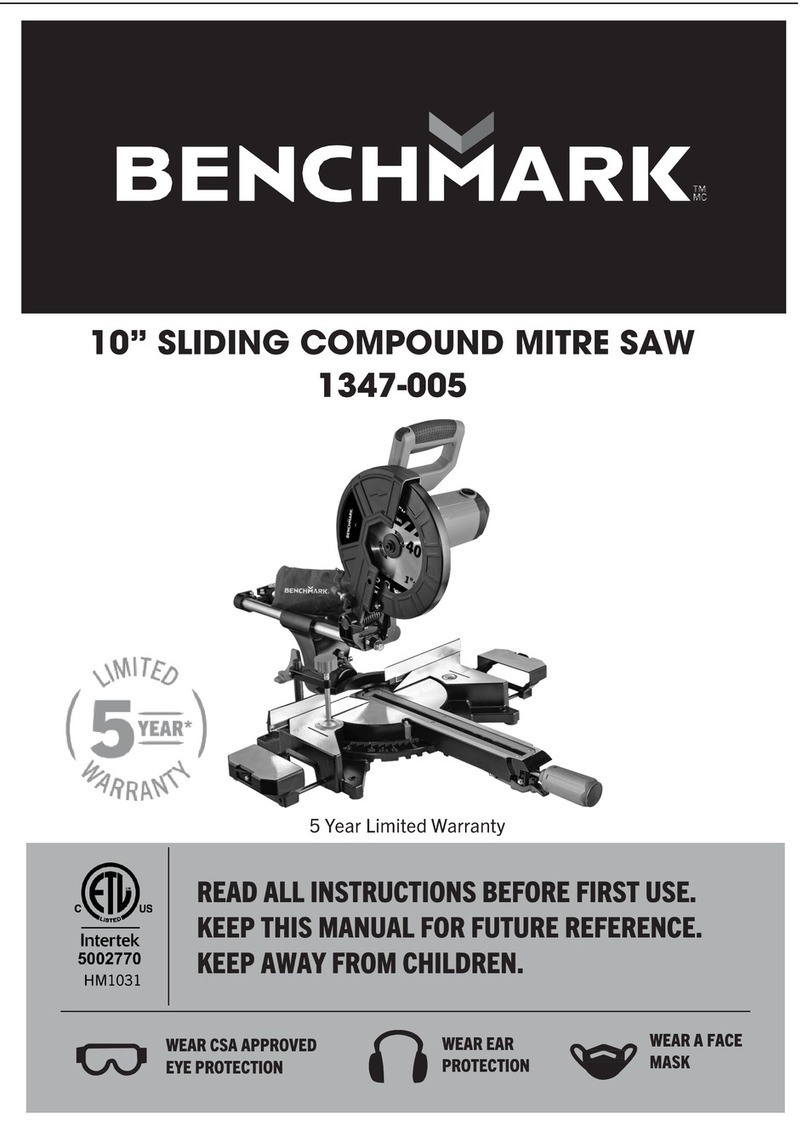
Benchmark
Benchmark 1347-005 manual
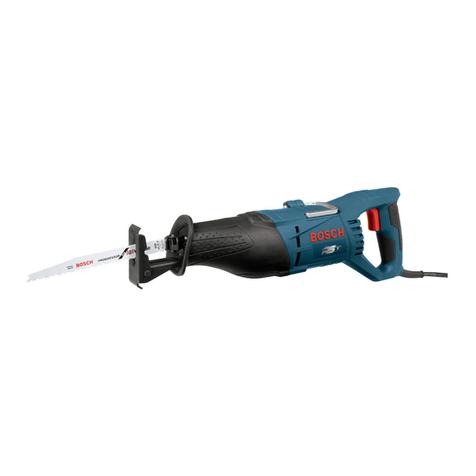
Bosch
Bosch 1-1/8 - RS7 Inch 11 Amp Receiprocating Saw Operating/safety instructions
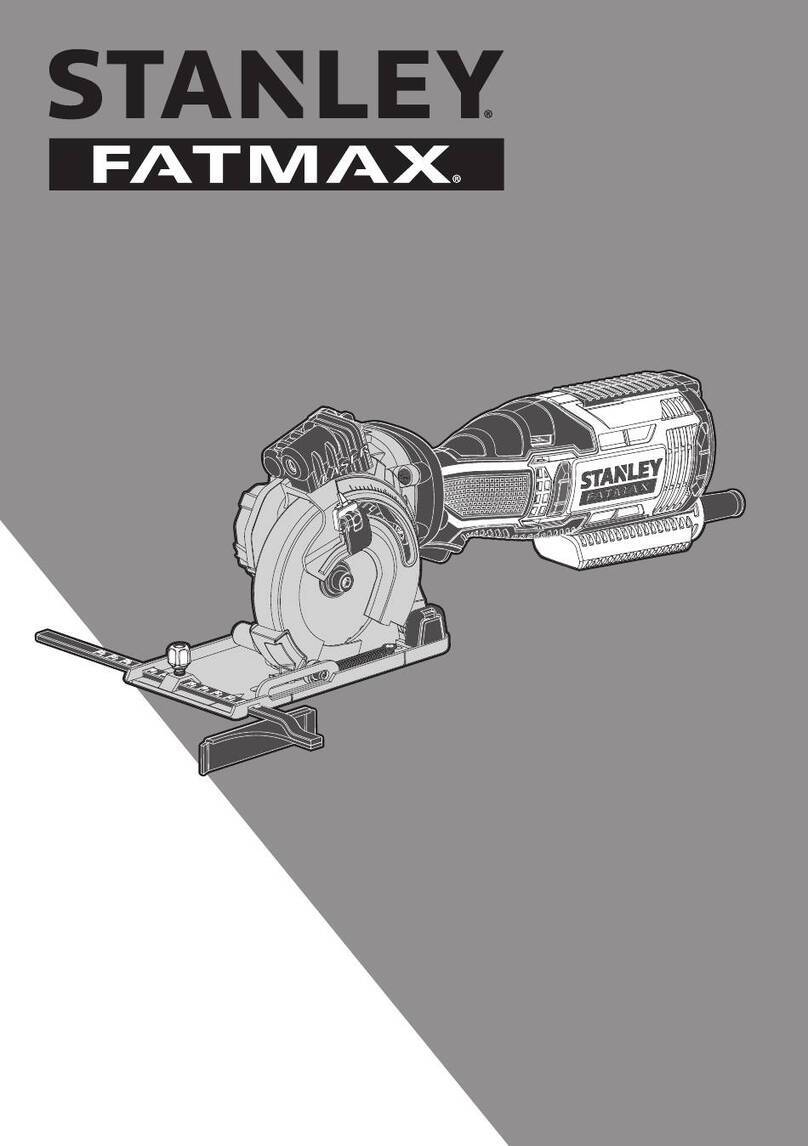
Stanley
Stanley FATMAX FME380 manual

Batavia
Batavia FIXXPACK BT-CRS004 operating instructions
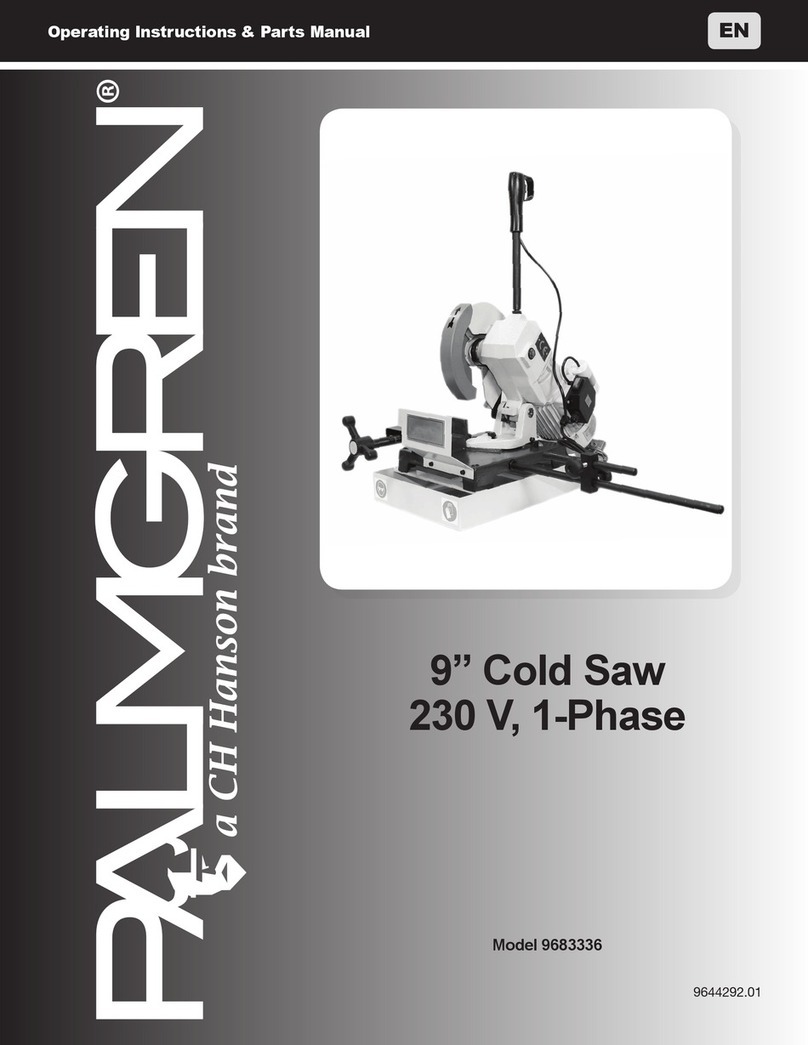
CH Hanson
CH Hanson PALMGREEN 9683336 Operating instructions & parts manual
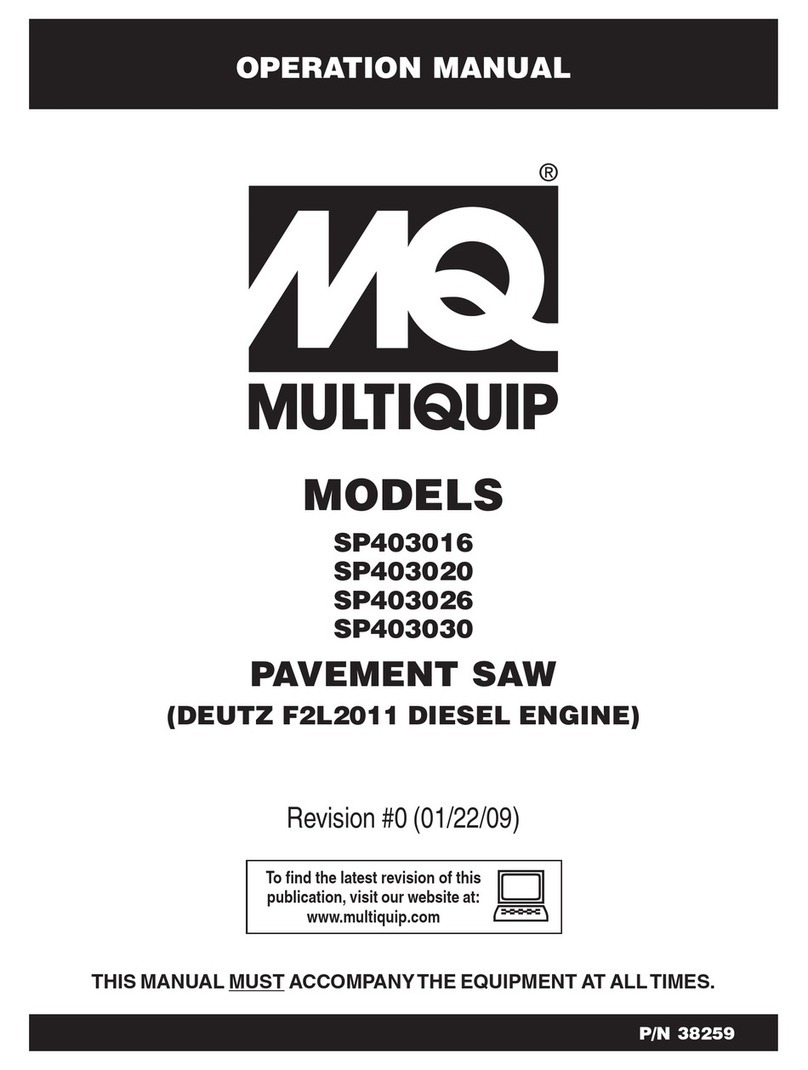
MULTIQUIP
MULTIQUIP SP403030 Operation manual
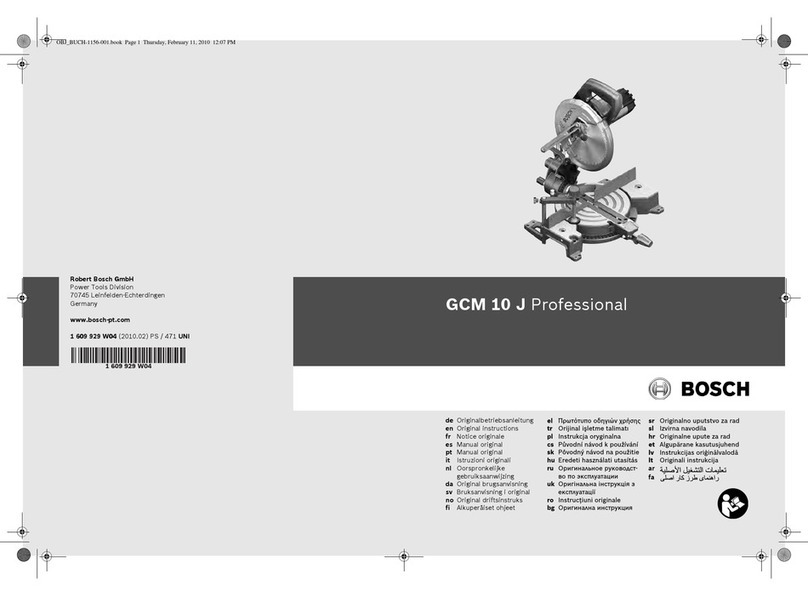
Bosch
Bosch GCM 10 J Original instructions

IQ Power Tools
IQ Power Tools iQMS362i Operator's manual
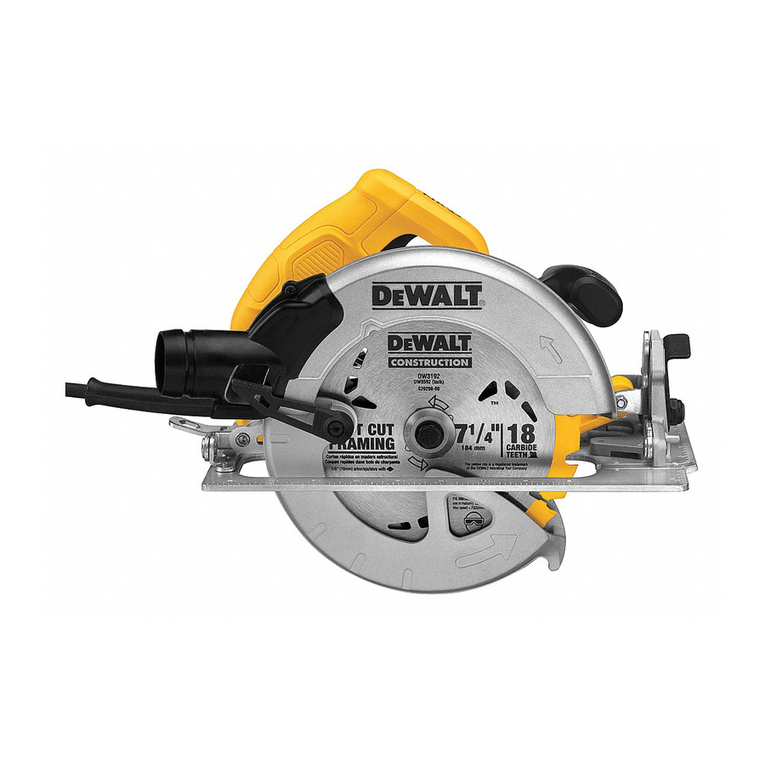
DeWalt
DeWalt DWE575 Original instructions

Chicago Electric
Chicago Electric 98199 Owner's and safety manual
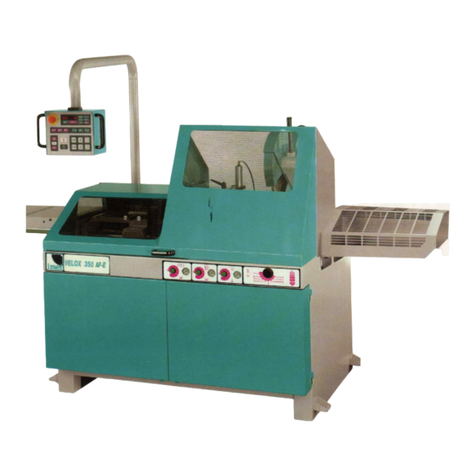
IMET Spa
IMET Spa VELOX 350 AF-E INSTRUCTION MANUAL, MAINTENANCE AND SPARE PARTS

Porter-Cable
Porter-Cable PCE300 instruction manual
